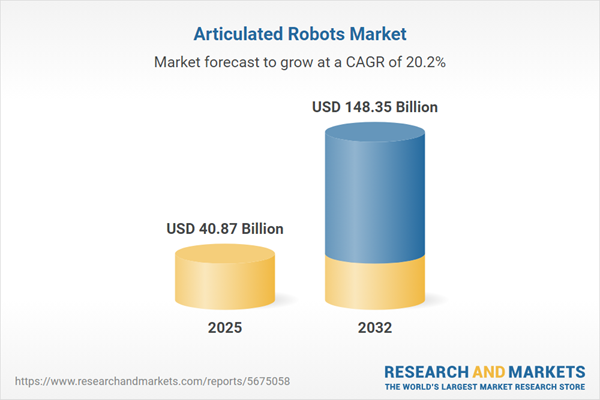Speak directly to the analyst to clarify any post sales queries you may have.
Articulated robots are redefining efficiency in manufacturing automation, empowering enterprises to improve adaptability and resilience as operational requirements evolve. For senior decision-makers, understanding the articulated robots market is paramount to developing successful automation strategies and sustaining long-term competitive positioning.
Market Snapshot: Articulated Robots Market Growth Dynamics
The articulated robots market is experiencing a period of robust growth, with revenues set to rise from USD 34.04 billion in 2024 to USD 40.87 billion by 2025, and projected to reach USD 148.35 billion by 2032. This expansion represents a 20.19% compound annual growth rate, powered by accelerating digital transformation and increasing automation investments across global industries. Automotive and electronics sectors are integrating these advanced robots for greater production consistency and scalability. Persistent supply chain pressures and evolving performance expectations are further prompting manufacturers to embed articulated robots within technology-driven manufacturing ecosystems.
Scope & Segmentation of the Articulated Robots Market
A clear understanding of market segments and drivers assists in aligning investments to maximize value. The following key segments shape the articulated robots market opportunity:
- Application Areas: Deployment spans automotive assembly, precision welding, and material handling, along with inspection, soldering, and pick-and-place tasks. The adoption is also rising in healthcare, food and beverage, metals, polymers, and pharmaceutical settings to improve quality and operational uptime.
- Payload Ranges: Solutions are available for lightweight operations (up to 5 Kg), mid-weight requirements (5–10 Kg), scalable industrial tasks (10–20 Kg), and heavy-duty assignments (above 20 Kg), supporting a variety of production needs.
- Robot Types: Four-axis articulations deliver core automation, SCARA robots provide high-precision repetitive movement, and six-axis variants offer adaptability for both collaborative processes and traditional operations.
- Mounting Designs: Ceiling, floor, wall, and table-mounted configurations are engineered to optimize layouts, enabling integration within brownfield and greenfield facilities.
- Operation Modes: Fully autonomous and semi-automatic models offer scalable options as business requirements shift.
- Geographic Coverage: The market includes the Americas, Europe, Middle East and Africa, and Asia-Pacific, each presenting unique considerations in automation maturity, infrastructure, and regulation.
- Leading Firms: Key suppliers include Fanuc Corporation, Yaskawa Electric Corporation, ABB Ltd., KUKA AG, Mitsubishi Electric Corporation, Kawasaki Heavy Industries, DENSO Corporation, Seiko Epson Corporation, Omron Corporation, and Universal Robots A/S, essential for benchmarking and strategic supplier evaluation.
Key Takeaways for Industrial Decision-Makers
- Articulated robots enable manufacturers to adjust production workflows rapidly, supporting responsiveness to changes in business priorities and operational requirements.
- Collaborative robot models enhance workplace safety and reinforce compliance, particularly in regulated environments where human-robot interaction is essential.
- Utilizing edge computing with real-time analytics allows for predictive maintenance and ongoing process improvement, reducing unplanned downtime and increasing overall productivity.
- Flexible, modular robotic platforms can be integrated into both legacy and new production facilities, offering solutions that address spatial and manufacturing constraints.
- Successful implementation demands consideration of local regulations, automation readiness, and robust integration planning to ensure consistency across multiple regions.
- Engagement with leading technology providers and industrial research organizations helps companies remain informed about automation advancements and optimize long-term returns on investment.
Tariff Impact on Global Robotics Sourcing
Adjustments to U.S. tariff structures are prompting companies to reassess their robotics sourcing strategies. By diversifying manufacturing locations and improving inventory controls, organizations are building more resilient supply chains and ensuring sustained access to automation technologies.
Methodology & Data Sources
This analysis incorporates structured interviews with industry leaders, direct input from equipment suppliers and system integrators, alongside reviews of industry benchmarks and published whitepapers. Insights from logistics intelligence and leading industrial research institutes enhance the data, supporting well-informed executive decision-making.
Why This Report Matters
- Provides strategic, data-backed guidance for executives responsible for automation investments amid regulatory and international complexity.
- Supports technical leaders with actionable intelligence for vendor selection, risk management, and efficient production planning.
- Facilitates supplier comparisons to increase confidence in automation deployments throughout diverse business units and regions.
Conclusion
Articulated robots are integral to advancing operational resilience and intelligent automation. This report gives senior leaders the data and insights needed to inform technology strategies and guide effective investment decisions.
Additional Product Information:
- Purchase of this report includes 1 year online access with quarterly updates.
- This report can be updated on request. Please contact our Customer Experience team using the Ask a Question widget on our website.
Table of Contents
3. Executive Summary
4. Market Overview
7. Cumulative Impact of Artificial Intelligence 2025
Companies Mentioned
The companies profiled in this Articulated Robots market report include:- Fanuc Corporation
- Yaskawa Electric Corporation
- ABB Ltd.
- KUKA AG
- Kawasaki Heavy Industries, Ltd.
- Mitsubishi Electric Corporation
- DENSO Corporation
- Seiko Epson Corporation
- Omron Corporation
- Universal Robots A/S
Table Information
| Report Attribute | Details |
|---|---|
| No. of Pages | 195 |
| Published | November 2025 |
| Forecast Period | 2025 - 2032 |
| Estimated Market Value ( USD | $ 40.87 Billion |
| Forecasted Market Value ( USD | $ 148.35 Billion |
| Compound Annual Growth Rate | 20.1% |
| Regions Covered | Global |
| No. of Companies Mentioned | 11 |









